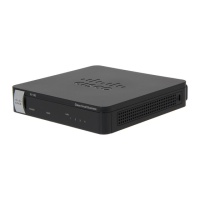Configuring Networking
Configuring the LAN (Local Network) Settings
Cisco RV180/RV180W Administration Guide 34
2
- Starting IP Address/Ending IP Address—Enter the first and last of the
contiguous addresses in the IP address pool. Any new DHCP client
joining the LAN is assigned an IP address in this range. You can save part
of the range for PCs with fixed addresses. These addresses should be in
the same IP address subnet as the Cisco RV180/RV180W's LAN IP
address.
- Primary DNS Server/Secondary DNS Server—DNS servers map
Internet domain names (for example, www.cisco.com) to IP addresses.
Enter the server IP addresses in these fields if you want to use different
DNS servers than are specified in your WAN settings.
- Lease time—Enter the duration (in hours) for which IP addresses are
leased to clients.
• DHCP Relay—Choose this option to configure the Cisco RV180/RV180W to
be a DHCP relay agent and enter the address of the remote DHCP server in
the Remote DHCP Server field. The relay agent transmits DHCP messages
between multiple subnets.
STEP 3 Click Save.
Configuring the DNS Proxy
You can also enable a DNS proxy. When enabled, the router then acts as a proxy
for all DNS requests and communicates with the ISP's DNS servers. When
disabled, all DHCP clients receive the DNS IP addresses of the ISP.
To configure the DNS proxy server for the Cisco RV180/RV180W:
STEP 1 Choose Networking > LAN (Local Network) > IPv4 LAN (Local Network).
STEP 2 In the DNS Proxy field, check to enable the Cisco RV180/RV180W to act as a
proxy for all DNS requests and communicate with the ISP's DNS servers.
STEP 3 Click Save.
Configuring Virtual LAN (VLAN) Membership
A VLAN is a group of endpoints in a network that are associated by function or
other shared characteristics. Unlike LANs, which are usually geographically based,
VLANs can group endpoints without regard to the physical location of the
equipment or users. You can create up to four new VLANS.

